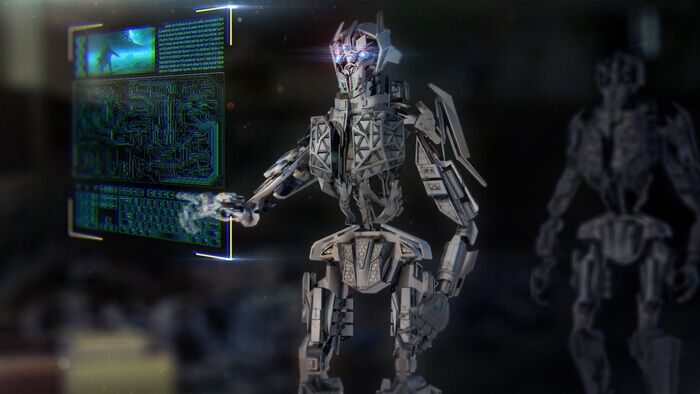
For a coon’s age, people dreamed of something like a babel fish from The Hitchhiker’s Guide to the Galaxy. That fish is placed in someone’s ear so that a person could hear any language translated into their language. A Chinese proverb says:
To learn a language is to have one more window from which to look at the world.
So, the more you know, the smarter you are. Wouldn’t it be great to understand a person speaking another language without the necessity to learn that language? Even if you learn some languages, no one is able to know all the languages and dialects in the world.
Machine Translation History
The idea of automatic translation has been around for centuries. It’s been put forward by such scientists as Leibniz and Descartes. But only with the emergence of computing devices in the twentieth century, the machine translation concept took shape. Here are the highlights of machine translation (MT):
- The first attempts of machine translation were made in the 1950s. The first dictionary included only 250 words and six grammar rules. However, this was enough to see the great future of MT. Many countries started to develop MT systems.
- After the ALPAC (Automatic Language Processing Advisory Committee) report in 1966, the funding for MT research was reduced significantly. The report highlighted the clumsiness, lack of accuracy, and high cost of MT compared to human translators and predicted a dismal future for MT development. Most worldwide MT research declined.
- In the late 1970s and early 1980s, research focused more on the rule-based approach that was less complicated than interlingua and more suited to working with multiple languages than a direct translation.
- In the 1990s, the third generation of machine translation systems emerged based on the statistical and example approaches. It formed the basis of translation memory tools.
- The Internet offered all the opportunities for the development of machine translation in the 2000s. Japan created speech-to-speech translations for mobile phones.
- In 2016 Google informed the public that the implementation of a neural network approach improved clarity across Google Translate. Computer systems with neural networks replaced memory-based functions.
- Recent developments in machine translation are the combination of deep learning and neural networks that increase accuracy. Neural-based MT engines are much more capable of spotting the meaning of a sentence and quickly replacing older statistical models.
Machine Translation is impressive technology and has come far from those early stages. Modern MT software can compete with human translators to an extent. We have gathered the most promising translation tools that help ease the translation process and improve efficiency, consistency, and quality.

Machine Translation Software
Translation software is designed to make the translation process faster and more efficient. Therefore, machine translation software is best suited when companies need quick, one-time translations, and accuracy is not so important.
- Google Translate. You definitely heard of it. It is the most popular machine translation software. It’s free, and it supports more languages than any other translation tool – over 100. Being a part of a large company with resources, Google Translate is improved continuously.
- Amazon Translate. A neural MT service that supports 71 languages. It is integrated into your business applications. Amazon Translate service is fee-based, where you pay for the number of characters of text you process and customize your plan according to these data.
- Microsoft Translator. The next software has over 70 languages available, and it’s already integrated into other Microsoft services. The service is free for general use.
- DeepL. With only 13 languages, DeepL’s strength is in the quality. Here, the machine learns extensively from reliable linguistic sources with or without human supervision. This free service helps to grasp the context and nuances that allow for more accurate and natural translations.
- Baidu Translate. The free Chinese equivalent of Google, so if your business is looking to localize in Chinese markets, Baidu Translate is a good option!
Machine Translation Advantages
With the constant technology development, the translation process is changing as well. Nowadays, machine translation allows translating entire documents by clicking the button. The question arises: why bother to search for a human translator to get the work done? The apparent strengths of machine translation are:
- Low cost. Professional translators demand enough money for each page, but we need just a general idea of what is said very often. In this case, the machine translation system is reliable and effective.
- Speed. MT enables you to save your time while translating large texts when you need to get the gist of some considerable amount of information.
- Multitasking. MT system is like the jack of all trades – it can translate any text of any area. In comparison, a professional translator specializes in a certain field. You can also translate between multiple languages using one tool.
- Privacy. This is about financial documents or private emails, for example, because you wouldn’t give your personal correspondence to some unknown translator as well as your financial affairs.
Machine Translation Challenges
Despite the abovementioned perks of MT, there are certain problems. You can only overcome them by hiring a human translator. So keep it in mind before choosing to use machine translation as these problems with the translation will become business problems if they are not resolved:
- Buy nice or buy twice. The cost can also be a negative factor. You should understand what quality you get with a free/cheap option.
- Easy does it. Similar to the above – if something is completed very quickly, there is generally a reasonable expectation that it will not be of high quality. Quality work takes more time, care, and attention.
- Lack of context. The MT process can take the same term when it appears in different sections of a document and translates it differently. On the contrary, a human translator ensures that terminology is consistent throughout a project. This attribute is crucial so you do not confuse your reader when referring to the same thing.
- The safety is at risk. How can you be sure that the information you put into the free MT solutions is secured? Such software is open for everybody, their engines are placed on servers somewhere, and one should choose the translation system vendor very thoughtfully.
- Formatting. Complex formatting can pose a severe issue for MT. It will segment text in the middle of sentences, which would make the MT have no context.
- Lack of creativity. The art of language involves a lot of creativity. This is important to understand when communicating on the global market with your clients. Human translators are more creative with the subject matter at hand and deliver a more creative solution that will resonate with your business partners or customers.

Alternatives for Machine Translation
For most companies, the cost and time required to add just one new language to a product are measured in substantial amounts of money and years. Because this addition includes UI apps, documentation, design solutions, SEO localization, etc. For example, a single license for SDL Trados Studio (one of the most popular CAT tools) can cost thousands of euros. In addition, it is only useful for one individual, and the customizations are limited.
There are spheres where it is hard or impossible to apply machine translation. Such field as technical writing, for instance. Since the technical terms in the documentation have specialized meaning and the translated text accuracy is crucial. In addition, technical documentation often needs content for translation, for example, a screenshot that completes a text. Or such things as code examples, a plethora of abbreviations, etc. Here’s when CAT tools are in place. These are standalone pieces of software requiring translators that use them to work locally and merge to a central repository.
Some documentation systems offer built-in translation tools. Specifically, ClickHelp offers a convenient translation editor that eases the translation process with automatic synchronization of changes and progress reports. Try it yourself if you want to improve human translators’ capacity, efficiency, and accuracy.
Conclusion
Machine translation has the benefits of quickly translating content at a low cost and constantly developing and solving many practical problems; it doesn’t cover all issues to the full extent. The challenges of MT can be resolved with human participation in the translation and localization process. And such human translators need special tools for that. In the technical writing field, these tools should be integrated into the tech writing system. ClickHelp aids technical writers to create multilingual documents providing built-in tools organizing the translation process.
Good luck with your technical writing!
ClickHelp Team
Author, host and deliver documentation across platforms and devices
 Elmirain Technical Writing on 7/7/2021 — 6 minute read
Elmirain Technical Writing on 7/7/2021 — 6 minute read Elmirain Technical Writing on 7/7/2021 — 6 minute read
Elmirain Technical Writing on 7/7/2021 — 6 minute read

